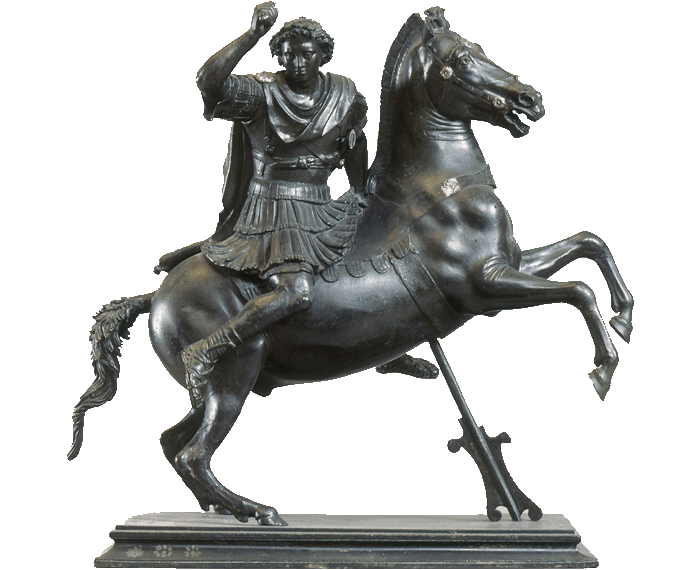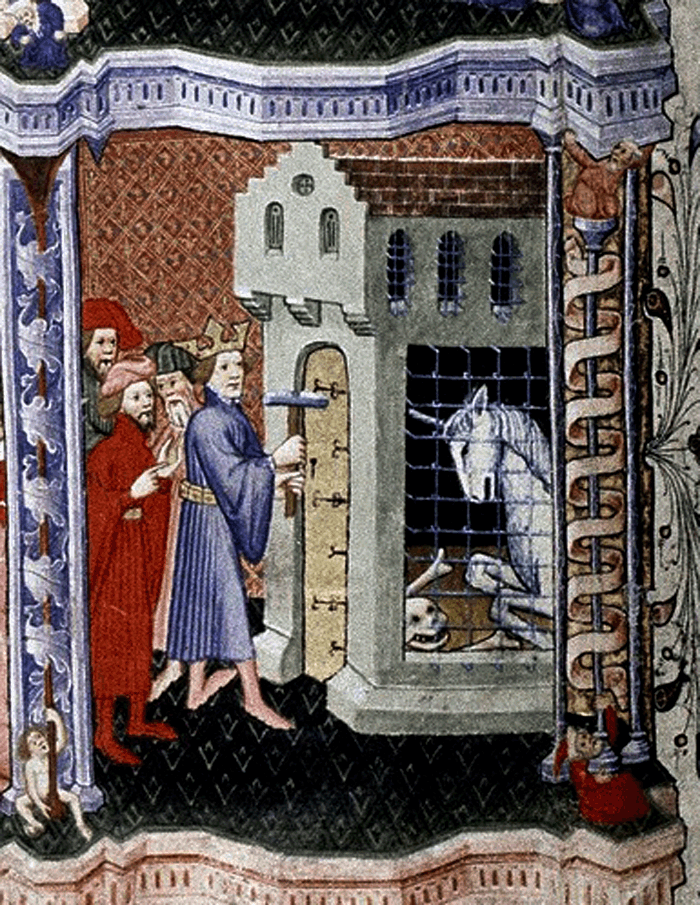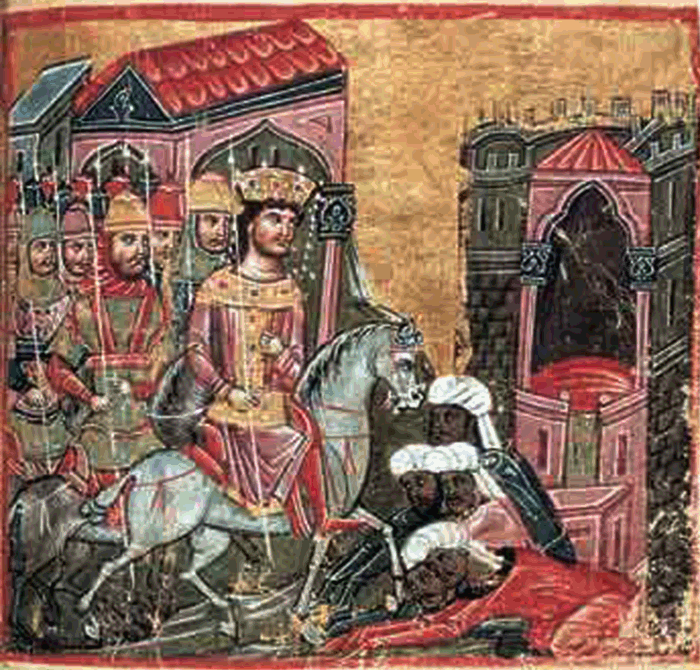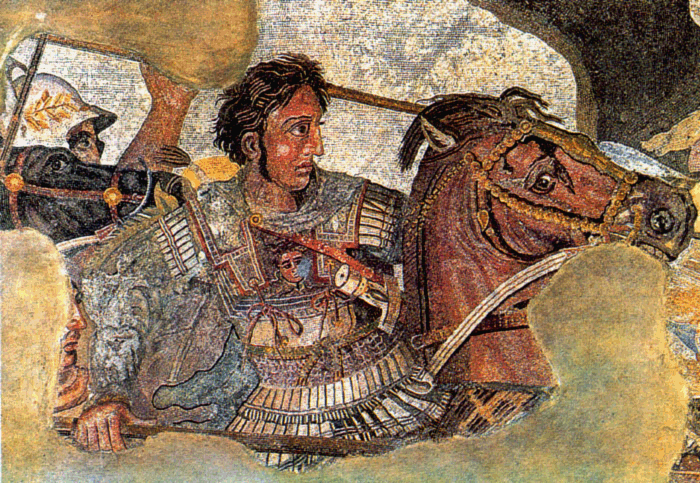|
The name Bucephalus
Byzantine commentators of ancient texts mention the use of the term "Bucephalus" to designate a specific Thessalian horses breed who their stamp was an ox head. This tradition followed by the sources, indicating that Bucephalus thigh was engraved with an ox head, and this interpretation of the name appears, therefore, most likely. The alternative origin of the name Bucephalus from a white sign similar with an ox head that was on his forehead from when he was born, as reported by Arrian, not certified in the few illustrations, which go back to Alexander's years. That the name Bucephalus comes, as reported by Strabo (XV, 698) by the breadth of his forehead, could possibly be combined with the testimony of Arrian that Bucephalus was bigger than normal, is however, also impossible to prove from the few works of art which illustrate him.

Bronze statuette of Alexander on Bucephalus 1st century BC-1st century AD
found during excavation of Herculaneum near Pompeii and now it is in the National Archaeological Museum of Naples
|
On the occasion of his name, later sources have given monster presentations of Bucephalus. That he had a head or horns from an ox and that the nickname Dikeratos (Double-horned), (Dho'l Qarnayn) which refers to Alexander in the Qur'an, comes basically from the horns of his horse. Monster depictions of Bucephalus with horns, apparently inspired by the mythical versions of history, are reflected in the tapestries, which were decorated with scenes from the adventures of Alexander. On the monster approaches of Bucephalus should being part, from this perspective, at least about his habit of eating people, and the poetic description from John Tzetzes (Byzantine poet 1110–1180), although certainly not regarded as a simple transfer intended to indicate only his wild nature:
«From Bucephalus all you got the history,
As horse he was tameless eating people.
He only obey to Macedonian Alexander
And thus he had Bucephalus call.
Having an ox head on the thigh stamp,
Definitely not had having ox head or horn»
|

King Philip lets the young Alexander tame the man-eating unicorn, Bucephalus.
It quite clearly shows a «traditional» looking unicorn surrounded by the bones of its victims,
and a bunch of scared courtiers huddled behind the brave unicorn tamer Alexander
|
Apart from Plutarch, who tells us that Bucephalus was from Thessaly and was bought by Philip after the successful effort of his young heir to tame him, a later source says that Bucephalus was from Cappadocia and was a gift to Philip when Alexander was about twelve years. The Cappadocian origin of Bucephalus is refered and to another source that says that Dimaratos from Corinth gave to Alexander «Bucephalus horse. And Cappadocian was it».
The fiction logic who governs all the non-historical references to Alexander had an influence on Bucephalus too. The legend that he was born from the union of an elephant and a dromedary camel, or an horse and a griffin, can not certainly be seen only through the dark prism of medieval Europe.
The close relationship of Bucephalus and Alexander, along with information of Arrian that the horse died in his thirtie years originally allowed associative correlations with the death of Alexander in his thirty three years. However, it is difficult to accept that Bucephalus was already thirteen or fourteen years old when Alexander tamed him. It is likely that the horse which met Alexander in Macedonia and took with him to Asia was not more than three or four years, if not less.
Even more pronounced is the attempt to match horse and rider in the Arabic version of the Alexander Romance, as preserved in the Ethiopian variant, which indicates that almost simultaneously with the conception of Alexander from Olympias with the eagle, lion and dragon Nectanebos, one of the mares of King Philip concepted Bucephalus, drinking water from the source that Nectanebos took his bath when he left Olympias.

Alexander horseback on Bucephalus enters India to meet with King Porus.
From the «Alexander Romance», 14th century. Hellenic Institute for Byzantine and Post-Byzantine Studies, Venice
|
The monster forms of the horse and his rider, as depicted on the occasion of the Pseudokallisthenis novel and the subsequent translations, adaptations or variations of it, can not contribute to our understanding of the history of Bucephalus. Neither course is possible, in the limited boundaries of this text, to include the ways in which the horse of Alexander was illustrated in the art of Europe or of the East. If you want to release Bucephalus from the transformations which he accepted over the long effect of the campaigns of Alexander in literature, art and popular consciousness, we need to concentrate in the few depictions of Alexander on horseback which dates back to his historical action or reflect his depictions which are associated with it.
If we accept that Alexander was about twelve when he obtained his Bucephalus, it is very likely that in the impressive mural from the hunt which is maintained on the facade of the tomb of Philip at Vergina, we should recognize on the horse of the young rider pictured in the center of the scene, apparently the earliest depiction of Bucephalus.
At the famous mosaic floor from Pompeii, all researchers recognize a copy from a great, now lost, painting of the 4th century BC, shown one of Alexander's great battles in the East. Reflection of the same painter who adorned with his fresco the facade of the tomb of Philip, the mosaic reproduces with admirable precision the iconographic details of the original, among them and Bucephalus, in the brown, but fragmentary preserved horse which Alexander is riding. It is a pity that none of the thighs from the depicted horse is saved, which would confirm or negate the information for the engraved ox head mentioned by the literary sources. On the contrary, it is clear that the information from Arrian that Bucephalus was black with a white sign similar to an ox head on his forehead, not certified or the mural with the hunt at Vergina nor, even more to the impressive, for the detailed production of the illustrated data on his painted prototype, mosaic floor from Pompeii. A mismatch, therefore, between the written and visual evidence should be interpreted more as inaccurate information to the author who wrote about Alexander five centuries after his action, rather than artistic arbitrariness of the contemporary with Alexander great painter of the late classical period who undertook to portray scenes from his action in Macedonia and Asia. The illustrations, therefore, of Bucephalus in two art works created at the time of Alexander certify that his horse was brown, without an ox head sign on his forehead.

Alexander rides on Bucephalus in his attack against Darius at the battle of Issous.
This is probably the most authentic representation of the favorite horse of Alexander.
Detail of the famous (Alexander Mosaic) in Pompeii
|
Bucephalus should we also recognize in a small bronze statuette (see above), depicting Alexander in equestrian activities and is believed that it reproduces part of a large total of copper projects from Lysippus, which the Macedonian king dedicated to the Sanctuary of Zeus, at Dion of Macedonia after the victorious battle at the Granicus River.
Finally, on the back of a commemorative silver coin (see above) that was released to mark the victory of the Macedonians against the Indians in 327 BC we have the finaly display of Alexander with Bucephalus, faced with Porus and his elephant, in the great battle on the banks of Hydaspes (Tzeloum), where near the place Tzalalpour of the long-suffering Central Asia, should we look for the city Alexander built to honor Bucephalus.
|
